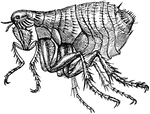Clipart tagged: ‘common flea’

Flea
An illustration of a common flea. Once the flea reaches adulthood its primary goal is to find blood…

Flea Larva
An illustration of the larva of a common flea. Flea larvae emerge from the eggs to feed on any available…

Flea Pupa
An illustration of the pupa of a common flea. After going through three larval stages they spin a silken…
